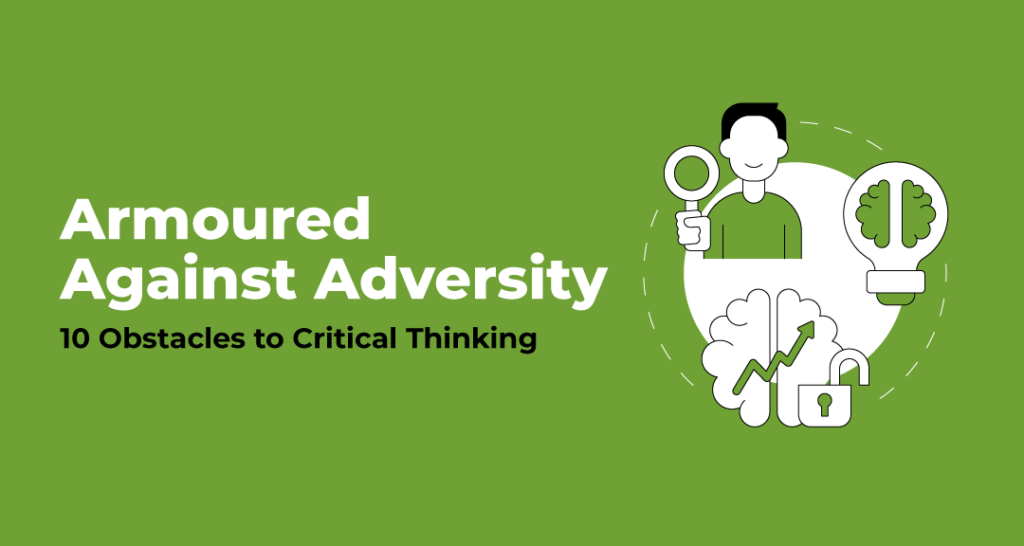Armoured Against Adversity: 10 Obstacles to Critical Thinking
- School Leaders
- October 12, 2024
- VOLT Learning

Critical thinking is an essential linchpin to personal growth and continuous learning. It prepares students to thrive in a world where the accelerated pace of technological and cultural shifts triggers leaps and bounds.
Students with incisive abilities can think outside the box, analyze challenges, and make more informed decisions faster. Promoting this skill is crucial in education, as it lays the foundation for lifelong learning and adaptability, equipping students with the cognitive tools to tackle challenges head-on.
As a fundamental cognitive skill, critical thinking also enables intellectual self-improvement by pushing students towards improved logical reasoning, academic excellence, and better exploration of real-world complexities by helping them understand the world around them.
Let’s examine the 10 most common pitfalls of critical thinking and the proven strategies teachers can implement within the classroom to help students conquer these pressing issues and become deeper thinkers.
10 Obstacles to Critical Thinking (and how to overcome them)
1. Confirmation Bias
- The Obstacle: Sometimes, students start believing in their existing beliefs that support their particular point of view and dismiss alternative perspectives that contradict them, limiting the exposure to diverse opinions.
- Overcoming Strategy: The best way to deal with egocentric thinking driven by confirmation bias is – to encourage students to be receptive towards different points of view. Let them engage in a daily practice of self-reflection wherein they seek out diverse viewpoints from multiple sources and willingly question their beliefs with an open mindset. This way, students are compelled to understand alternative opinions and develop high tolerance with improved understanding.
2. Allostatic Overload
- The Obstacle: Many students, when faced with compounding feelings of overwhelming stress, tend to struggle to relax, feel safe, or even have fun. Their body and mind are on red alert.
- Overcoming Strategy: Promote a friendly and safe classroom culture so students can consciously release stress. Encourage healthy conversations wherein they feel safe and can independently identify their stressors—both external and internal. Involve them in regular positive affirmations to quickly overcome the allostatic load.
3. Emotional Influence
- The Obstacle: Students sometimes get emotional, leading to biased thoughts.
- Overcoming Strategy: Instruct students to handle emotions with mindfulness techniques. Describe situations that cause emotions and objectively consider their examples, thus encouraging rational reasoning.
4. Mental Shortcuts (Heuristics)
- The Obstacle: Many students make rational choices by relying on biased and informal information. As a result, they facilitate problem-solving and probability judgments.
- Overcoming Strategy: Teach students problems instead of offering decisions to avoid hasty decisions and conclusions. The author advised them to help them analyze a situation by first decomposing it to consider all angles of decision-making.
5. Groupthink
- The Obstacle: In group settings, students may conform to the consensus instead of voicing their unique viewpoints.
- Overcoming Strategy: Promote respect for the individual differences among the students in your classroom. Engage them in group activities that delegate various tasks, helping each participant work on his or her ideas without consulting the group members before proceeding as a single unit.
6. Limited Perspective
- The Obstacle: Students often approach problems from a limited viewpoint, failing to consider other perspectives.
- Overcoming Strategy: Introduce cross-cultural topics or historical case studies that challenge students to analyze events or ideas from multiple angles. Encourage discussions that celebrate diversity and broaden understanding.
7. Drone Mentality and Cognitive Fatigue
- The Obstacle: Due to a lack of spatial awareness, students struggle with a drone mentality—the major obstacle to critical thinking—and fail to identify problems and analyze situations for effective problem-solving.
- Overcoming Strategy: The primary step is to promote self-awareness among students who are struggling with drone mentality. Teachers must focus on conducting self-control exercises, which encourage appropriate stimulation. Also, teachers inside the classroom can challenge the students to adopt fresh thoughts and fuel their curiosity while making the learning environment exciting and innovative.
8. Arrogance and Intolerance
- The Obstacle: This is a common barrier to critical thinking in students, adversely making negative impact on their capability of thinking out of the box with an open mindset.
- Overcoming Strategy: Teachers must help students practice self-control over arrogance and intolerance by promoting characteristics like nonjudgment, patience, open-mindedness, and permissiveness. Additionally, teachers can have open communication with the students and make them understand that we should always treat others respectfully.
9. Dependency on External Validation
- The Obstacle: Students often look to others for validation, hindering their ability to form independent opinions.
- Overcoming Strategy: Encourage self-reflection and critical self-assessment. Create assignments where students justify their viewpoints with evidence, building confidence in their reasoning abilities.
10. Resistance to Change
- The Obstacle: Students may resist changing their views or considering alternative ideas due to fear of the unknown.
- Overcoming Strategy: Help students embrace change by gradually introducing new concepts. Use project-based learning that includes incremental challenges, making them more open to evolving ideas and adaptable to new perspectives.
Bring Critical Thinking to life with VOLT.
Putting critical thinking at the forefront will help teachers create a welcoming environment inside the classroom so that students can feel empowered to analyze, question, and understand the world around them.
VOLT Reasoning and Aptitude is one of the best choices in the education landscape. We help parents and teachers promote critical thinking among students from an early age. We provide expertly curated books that provide essential information to teachers and parents on the mental tools necessary to analyze information, evaluate arguments, and make informed decisions.
With VOLT Reasoning and Aptitude, teachers can prepare for the numerous challenges related to student critical thinking skill development and guide them with the best strategies. The course offers a wide array of digital teaching resources that help make classrooms engaging and effective.
You can check VOLT Reasoning and Aptitude.



